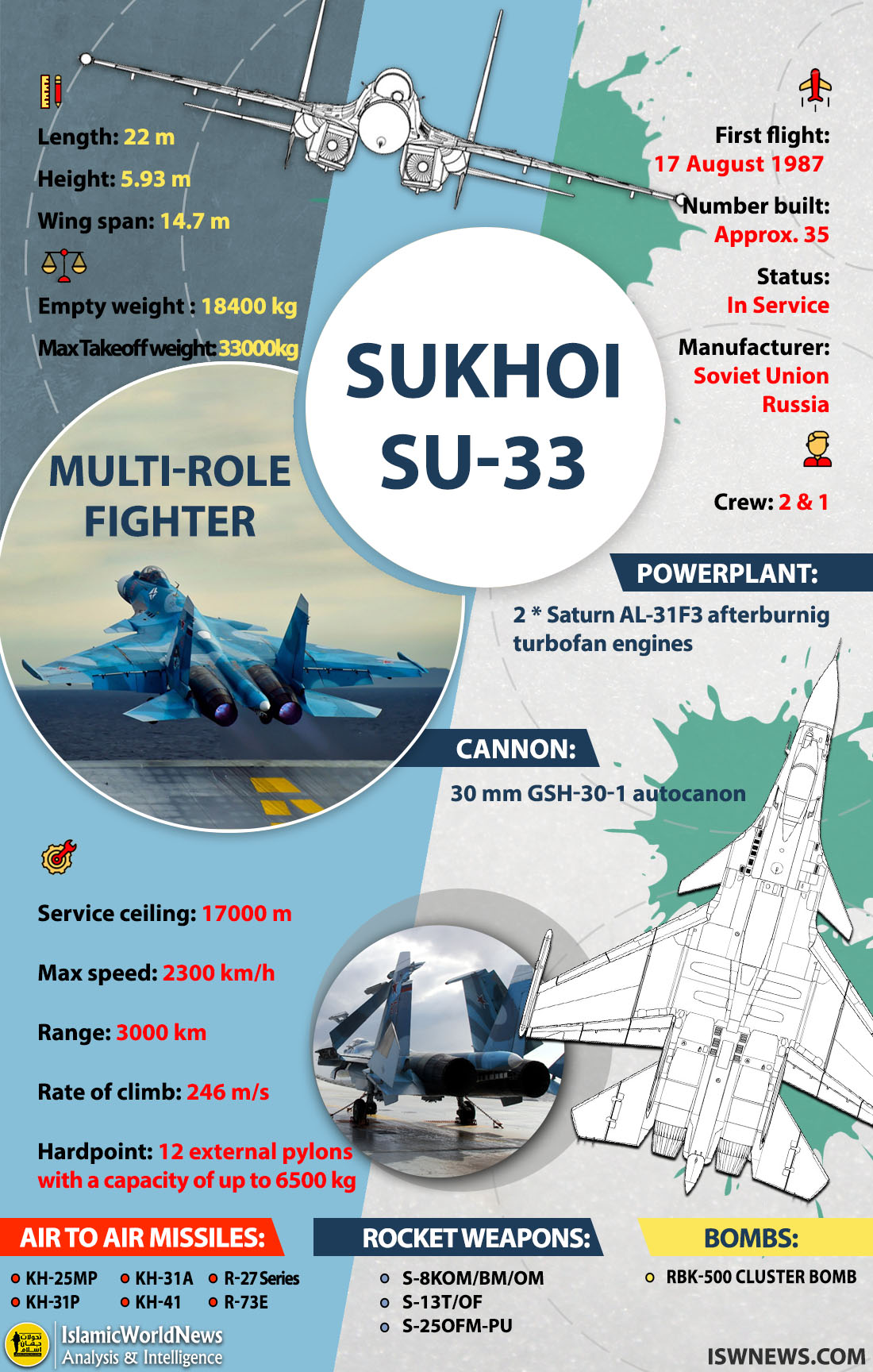Military Knowledge: Sukhoi Su-33 Multirole Fighter Jet

The Sukhoi Su-33, NATO reporting name: Flanker-D is an all-weather carrier-based twin-engine air superiority fighter designed by Sukhoi and manufactured by Komsomolsk-on-Amur Aircraft Production Association, derived from the Su-27 and initially known as the Su-27K.
Specifications:
– Carrier-based air superiority fighter and multirole fighter
– Origin: Soviet Union / Russia
– Design group: Sukhoi
– Built by Sukhoi, Komsomolsk-on-Amur Aircraft Production Association
– First flight: 17 August 1987
– Produced: 1987–1999
– Status: In service
– Number built: Approx. 35
– Crew: 2-seat, 1-seat
– Length: 22 meters
– Wingspan: 14.7 meters
– Height: 5.93 meters
– Empty weight: 18400 kg
– Max takeoff weight: 33000 kg
– Powerplant: 2 × Saturn AL-31F3 afterburning turbofan engines
Performance:
– Maximum speed: 2300 km/h
– Range: 3000 km
– Service ceiling: 17000 m
– Rate of climb: 246 m/s
Armament:
– Hardpoints: 12 external pylons with a capacity of up to 6500 kg
– Cannon: 1 × 30 mm Gryazev-Shipunov GSh-30-1 autocannon with 150 rounds
– Missiles:
Air-to-air missiles: R-27R/ER/T/ET and R-73E
Anti-ship missiles: Kh-31A and Kh-41
Anti-radiation missiles: Kh-25MP and Kh-31P
– Rockets:
S-8KOM/BM/OM
S-13T/OF
S-25OFM-PU
– Bombs:
RBK-500 cluster bomb

The Sukhoi Su-33, NATO reporting name: Flanker-D is an all-weather carrier-based twin-engine air superiority fighter designed by Sukhoi and manufactured by Komsomolsk-on-Amur Aircraft Production Association, derived from the Su-27 and initially known as the Su-27K. The aircraft has been principally designed and developed to meet the requirements of the Russian Navy.
Compared with the Su-27, the Su-33 has a strengthened undercarriage and structure, folding wings and stabilators, all for carrier operations. The Su-33 has canards and its wings are larger than the Su-27 for increased lift. The Su-33 has upgraded engines and a twin nose wheel, and is air refuelable.
Su-33 aircraft design
The aircraft was designed by Russia’s Sukhoi Design Bureau. The design phase began in 1984 and was finalised in 1985. The aircraft is equipped with sports canards to reduce the take-off distance and enhance manoeuvrability, and has power-aided folding wings. The aircraft is also fitted with an air-refuelling probe to increase its range. The wings are fitted with a two-piece, single-slotted flap, an aileron and a larger leading-edge flap to decrease speed when landing.
Variants
– Su-27K: Carrier-based version of the Su-27 designed for Project 11435 and Project 1160 aircraft carriers (heavy aircraft cruisers in Soviet classification).
– Su-27KI: Project of a carrier-based version of the Su-27 designed for Project 11435 and Project 1153 aircraft carriers (heavy aircraft cruisers in Soviet classification).
– Su-27KPP: Project of a two-seat carrier-based electronic-warfare aircraft. – – Su-27KRS: Project of a two-seat carrier-based reconnaissance and target designation aircraft.
– Su-27KT/Su-27KTZ: Project of a carrier-based tanker aircraft.
– Su-27KU: Project of a two-seat carrier-based trainer.
– Su-27KSH: Project of a carrier-based attack aircraft.
– Su-28K: Project of a two-seat carrier-based attack aircraft.
– Su-28KRS: Project of a carrier-based reconnaissance and target designation aircraft based on the Su-28K.
– Su-29K: Project of a carrier-based interceptor aircraft with a possibility to carry the long-range R-33 air-to-air missiles.
– Su-33: Designation for the Su-27K after its introduction into service with the Russian Naval Aviation on 31 August 1998.
– Su-27KUB/Su-33UB: Two-seat training-and-combat version based on the Su-27K and Su-27KU with side-by-side seating for crew of two. One prototype built.




















Comment